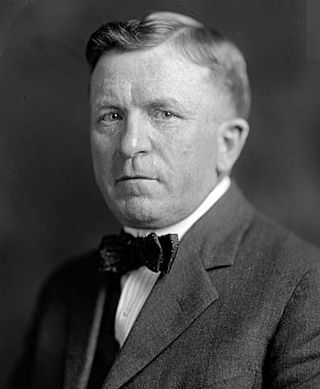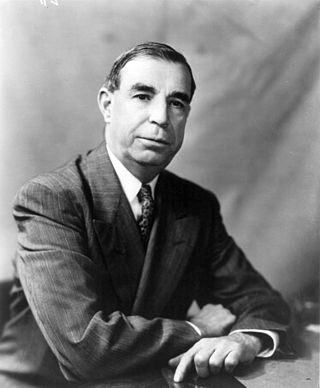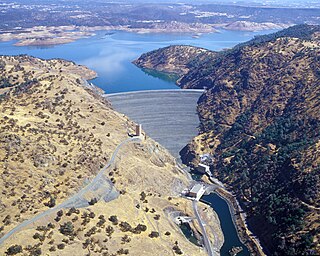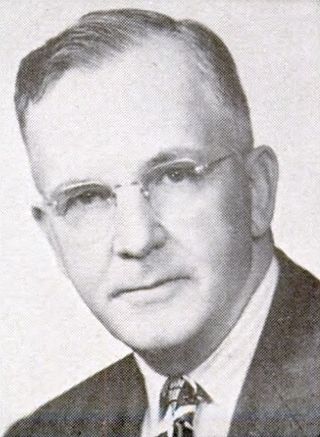
The Reclamation Act of 1902 is a United States federal law that funded irrigation projects for the arid lands of 20 states in the American West.

Grand Coulee Dam is a concrete gravity dam on the Columbia River in the U.S. state of Washington, built to produce hydroelectric power and provide irrigation water. Constructed between 1933 and 1942, Grand Coulee originally had two powerhouses. The third powerhouse ("Nat"), completed in 1974 to increase energy production, makes Grand Coulee the largest power station in the United States by nameplate capacity at 6,809 MW.

Frederick Haynes Newell, served as the first Director of the United States Reclamation Service and was born in Bradford, Pennsylvania. He graduated in 1885 from the Massachusetts Institute of Technology and after field experience in Colorado and other states was appointed on October 2, 1888, as Assistant Hydraulic Engineer of the United States Geological Survey, being the first aide designated under Major John Wesley Powell to investigate the extent to which the arid regions of the United States might be reclaimed by irrigation. He was subsequently appointed Chief of the Hydrographic Branch.

The Bureau of Reclamation, formerly the United States Reclamation Service, is a federal agency under the U.S. Department of the Interior, which oversees water resource management, specifically as it applies to the oversight and operation of the diversion, delivery, and storage projects that it has built throughout the western United States for irrigation, water supply, and attendant hydroelectric power generation. It is currently the U.S.'s largest wholesaler of water, bringing water to more than 31 million people, and providing one in five Western farmers with irrigation water for 10 million acres of farmland, which produce 60% of the nation's vegetables and 25% of its fruits and nuts. The Bureau is also the second largest producer of hydroelectric power in the western U.S.

David William Davis was an American politician who served as the 12th governor of Idaho from 1919 to 1923. He later served briefly as commissioner of the United States Bureau of Reclamation in 1923 and 1925. He later became a special assistant to the United States Secretary of the Interior.
The Desert Land Act is a United States federal law which was passed by the United States Congress on March 3, 1877, to encourage and promote the economic development of the arid and semiarid public lands within certain states of the Western states. Through the Act, United States citizens, or those declaring an intent to become a citizen, over the age of 21 may apply for a desert-land entry to irrigate and reclaim the land. This act amended the Homestead Act of 1862. Originally the act offered 640 acres (2.6 km2), although currently only 320 acres may be claimed.

Carl Trumbull Hayden was an American politician. Representing Arizona in the United States Senate from 1927 to 1969, he was the first U.S. Senator to serve seven terms. Serving as the state's first Representative for eight terms before entering the Senate, Hayden set the record as the longest-serving member of the United States Congress more than a decade before his retirement from politics. He was Dean of the United States Senate and served as its president pro tempore and chairman of both its Rules and Administration and Appropriations committees. He was a member of the Democratic Party. Hayden was also the last remaining member of Congress to have served during the presidencies of William Howard Taft and Woodrow Wilson, as he retired in 1969.

Dionisio "Dennis" Chávez was an American politician who served in the United States House of Representatives from 1931 to 1935, and in the United States Senate from 1935 to 1962. He was the first Hispanic to be elected to a full term in the US Senate and the first US Senator to be born in New Mexico, which was still a US territory at the time of his birth.

The Columbia Basin Project in Central Washington, United States, is the irrigation network that the Grand Coulee Dam makes possible. It is the largest water reclamation project in the United States, supplying irrigation water to over 670,000 acres (2,700 km2) of the 1,100,000 acres (4,500 km2) large project area, all of which was originally intended to be supplied and is still classified irrigable and open for the possible enlargement of the system. Water pumped from the Columbia River is carried over 331 miles (533 km) of main canals, stored in a number of reservoirs, then fed into 1,339 miles (2,155 km) of lateral irrigation canals, and out into 3,500 miles (5,600 km) of drains and wasteways. The Grand Coulee Dam, powerplant, and various other parts of the CBP are operated by the Bureau of Reclamation. There are three irrigation districts in the project area, which operate additional local facilities.

The Residence Act of 1790, officially titled An Act for establishing the temporary and permanent seat of the Government of the United States, is a United States federal statute adopted during the second session of the 1st United States Congress and signed into law by President George Washington on July 16, 1790. The Act provides for a national capital and permanent seat of government to be established at a site along the Potomac River and empowered President Washington to appoint commissioners to oversee the project. It also set a deadline of December 1800 for the capital to be ready, and designated Philadelphia as the nation's temporary capital while the new seat of government was being built. At the time, the federal government operated out of New York City.

The 69th United States Congress was a meeting of the legislative branch of the United States federal government, consisting of the United States Senate and the United States House of Representatives. It met in Washington, D.C. from March 4, 1925, to March 4, 1927, during the third and fourth years of Calvin Coolidge's presidency. The apportionment of seats in the House of Representatives was based on the 1910 United States census.

The 67th United States Congress was a meeting of the legislative branch of the United States federal government, consisting of the United States Senate and the United States House of Representatives. It met in Washington, D.C., from March 4, 1921, to March 4, 1923, during the first two years of Warren Harding's presidency. The apportionment of seats in the House of Representatives was based on the 1910 United States census.

New Melones Dam is an earth and rock filled embankment dam on the Stanislaus River, about 5 miles (8.0 km) west of Jamestown, California, United States, on the border of Calaveras County and Tuolumne County. The water impounded by the 625-foot-tall (191 m) dam forms New Melones Lake, California's fourth-largest reservoir, in the foothills of the Sierra Nevada east of the San Joaquin Valley. The dam serves mainly for irrigation water supply, and also provides hydropower generation, flood control, and recreation benefits.

The 68th United States Congress was a meeting of the legislative branch of the United States federal government, consisting of the United States Senate and the United States House of Representatives. It met in Washington, D.C., from March 4, 1923, to March 4, 1925, during the last months of Warren G. Harding's presidency, and the first years of the administration of his successor, Calvin Coolidge. The apportionment of seats in the House of Representatives was based on the 1910 United States census.

Francis Griffith Newlands was an American politician and land developer who served as United States representative and Senator from Nevada and a member of the Democratic Party.

Addison Taylor Smith was a congressman from Idaho. Smith served as a Republican in the U.S. House for ten terms, from 1913 to 1933.

Wesley Abner D'Ewart was a U.S. Republican politician who served in the United States House of Representatives from Montana's 2nd congressional district from June 5, 1945, to January 3, 1955.

The Consolidated Natural Resources Act of 2008 was an act passed in the 110th United States Congress and enacted on May 8, 2008.

Keith Sebelius Lake, formerly known as Norton Reservoir, is a man-made reservoir on Prairie Dog Creek in northwest Kansas. Built and managed by the U.S. Bureau of Reclamation, it is used for flood control, irrigation, recreation, and local water supply. Prairie Dog State Park is located on its shore.

Rio Grande Silvery Minnow v. Bureau of Reclamation, called Rio Grande Silvery Minnow v. Keys in its earlier phases, was a case launched in 1999 by a group of environmentalists against the United States Bureau of Reclamation and the United States Army Corps of Engineers alleging violations of the Endangered Species Act and the National Environmental Policy Act. The case resulted in significant changes to water and river management in the Middle Rio Grande Basin of New Mexico in an effort to reverse the damage that had been done to the habitat of two endangered species.















